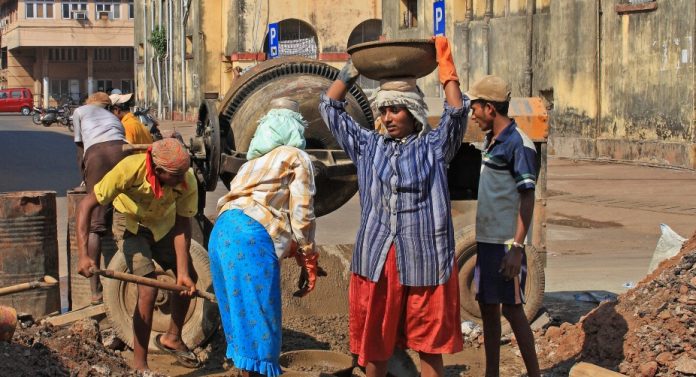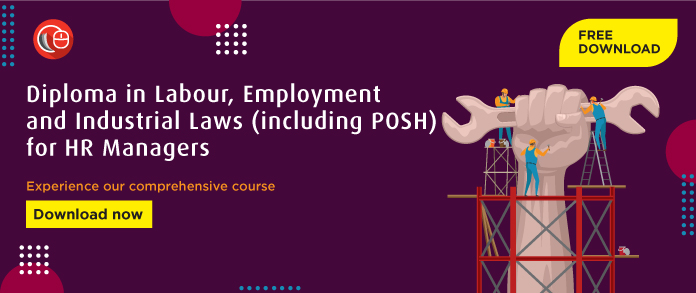This article is written by Sharma Amitkumar Rampratap who is pursuing a Diploma in Labour, Employment and Industrial Laws (including POSH) for HR Managers from LawSikho.
Table of Contents
Introduction
A safe workplace is a basic right. India’s record of promoting safety in the workplace and industry remains weak despite economic growth. According to statistics, about 80,000 workers who lose their lives each year are “in danger” at work. The Department of Labor and Employment has established the Occupational Safety, Health and Conditions Code, 2019 (“Code”) in accordance with 13 labor laws relating to safety, health standards, working conditions, social benefits, leaves and working hours. These Rules serve as the law governing the health and safety conditions of workers in a building with 10 or more employees, and in all mines and ports.
The Code was introduced in Lok Sabha on 23 July 2019 where, it was submitted to the Standing Committee on 9 October 2019 and finally on 11 February 2020, the Standing Committee submitted its code report.
Provisions of Code of Safety, Health and Terms of Service
Some of the key conditions of the OSH code are below:
- Contractor Work: “Contract work” is defined as an employee who is considered to be employed / in relation to the employment of the institution where the employee is recognized by the contractor, the principal employer or unknowingly.
- Employee: “Employee” means the means by which a person is employed (either explicitly or implicitly) on institutional salaries to perform any skilled, unskilled, manual, manual, administrative, management, administrative, technical, secretarial or other work.
- Employer: The OSH Code defines an “employer” as a tenant, either directly or through any other person, or in his or her name, or on behalf of any person, one or more employees in his or her institution, and includes, inter alia, the person / officer in charge last position above the institution and contractor.
- Establishment: “Institution” (i) is any place with ten or more employees in which any sector, trade, business, production or occupation is conducted.
Risk Process: The OSH Code defines “hazardous process” as any process or concern in respect of certain industries (set out in Schedule I of the OSH Code), where, unless a special manager is taken, raw/medium/finished/finished products, etc., as the template can be, it can be:
- It has caused a material impairment in the lives of the participants or those who are negligent in this regard; or cause uncontrolled environmental pollution.• Principal Employer: For the purposes of the OSH Code, a “principal employer” is (i) any person responsible for the supervision and tenancy of the establishment where contract labour is employed or engaged; or (ii) the owner or the occupier of the factory and where a person has been named as the manager of the factory, the person so named.
- Salaries: “Salaries”, according to the OSH Code, contains all salaries such as salaries, solatium or other means, expressed in monetary terms.
- The OSH code stipulates that salaries do not include (a) a bonus; (b) the amount of travel or light, water, access to medical care; (c) the employer’s contribution to any pension or provident fund; (d) distribution assignment; (e) the amount paid to the employee for special expenses; (f) housing allowance; (g) overtime pay and (h) generosity, etc.
1.8 Employees: Definition of “employees” under the OSH Code, while similar to the definition of “employees” under the Contract Labor (Regulation and Abolition) Act. 1971, does not exclude the sweeping of any person employed in administrative matters earning more than Rs. 18,000 / – (Rupees Eighteen Thousand only) per month or any other amount that may be declared by the Central Government.
Employer Responsibilities
Under the OSH Code, every employer is required to do the following:
Section 6 of the Operating, Health and Labor Regulations 2020 describes below the employer’s duties with regard to mining:
(a) The employer must keep the workplace safe and secure to the health of the employees.
(b) The employer must make all necessary arrangements to ensure the safety and well-being of the miners with regard to the management, storage and transportation of goods.
(c) The employer must provide information, training and supervision as it is mandatory to ensure the health and safety of all employees.
(d) It is the employer’s responsibility to maintain a safe, healthy & non-hazardous work environment and that provision is provided for the maintenance of a safe environment.
(e) The employer must continue to maintain and monitor his or her workplace and work environment so as not to endanger it, health or safety.
Employee Rights
Every employee has the following rights under the OSH Code:
Article 14. Employee rights:
(1) Every employee in a particular area shall have the right to obtain from the employer information relating to the health and safety of the employee and to represent the employer directly or through a member of the Safety Committee as contemplated in section 22.
(2) Continuing above paragraph 1, if an employee considers that the workplace is a workplace hazard or possibly serious injury or death or health hazard, he or she may immediately notify his or her employer, safety committee or cum-Facilitator.
(3) An employer or employee recognizes such danger or danger in the workplace; it should be reported immediately of the corrective actions taken to the cum-facilitator inspector in the prescribed manner.
(4) If the employer does not take steps to remedy any impending danger to the employee, rather than refer the employee to a cum-facilitator, which is his or her decision which will ultimately result in such circumstances.
Constitution of Advisory Boards
The OSH Code provides for the constitution of the National Occupational Safety and Health Advisory Board (“National Advisory Board”) by the Central Government, which will be empowered to educate the Central Government on matters relating to (i) standards, laws and regulations must be under the OSH Code; (ii) the implementation of the provision of the OSH Code; and (iii) the issuance of occupational safety and health policy; and any other matters referred to it. In addition, the OSH Code further considers the distribution of a common bench at the state level (“State Advisory Board”), in order to give due consideration to the relevant Government Governments on issues such as these arising from OSH Code slavery in Government.
Health, Safety and Conditions
The employer is required to provide and maintain social services for employees as may be determined by the Central Government including (i) unsuitable and appropriate bathing facilities for male and female employees separately; (ii) bathrooms and locker rooms for male, female and transgender staff separately; (iii) accommodation arrangements for all compulsory labor; (iv) first aid boxes or non-removable cabinets with easy-to-use content at all times of operation; and (v) any other social security measures that the Central Government considers, subject to the circumstances, as required by the appropriate standard of living of the employees.
In addition, the Central Government has the right to order the provision of, inter alia, (i) cleanliness and hygiene; (ii) air, heat and humidity; (iii) an irreversible level of humidity; (iv) drinking water; (v) unfavorable lighting; (vi) irreversible standards to prevent congestion, etc.
Hiring of Contractors and Immigrant Workers
The OSH code has changed the number of small contract workers to fifty (50) from twenty (20) for the use of the OSH code. Social facilities as defined under the OSH Code must be provided to the primary employer of that institution in the employee contract employed at that institution.
In a move that should be seen as beneficial, the OSH Code provides a global license for the factory, beedi industrial and tobacco industry and the involvement of contract workers. It has been clarified from a distance that no contractor is allowed to engage in any employee work unless he or she is not licensed under the OSH code.
In addition, the OSH Code protects the rights of Inter-State Migrant Workers by ensuring that the contractor transfers all benefits as it is the unfair dismissal of women under various labor laws and for foreign workers.
Employment of women
Section 43 of Occupational Safety, Health & Working Conditions Code, 2020 describes that a woman shall be entitled for employment with their consent of working before 6 a.m & beyond 7 p.m subject to such conditions relating to safety, holidays & working hours or any other conditions prescribed by the appropriate government.
Penalties for Non-compliance of OSH Code
To prevent violations of this Code, strict penalties have been introduced. For example, a fine of up to INR 20 lacs is applicable if the employer violates any of the provisions of the Code, which do not differ from a specific fine.
Certain fines for various cases are provided under the Code. For example, if a person fails to comply with the Code and such failure results in an accident that results in death or serious bodily injury, the offender will be liable to imprisonment for up to two years, plus a fine.
In the event of an accident or physical injury, the courts are empowered to pay a portion of the fine (not less than 50%) to the victim or his or her legal heirs.
In addition, other offenses such as willful attempt to prevent the Inspector from performing his duties under the Code or failure to produce documents or failure to comply with any request or order issued, may be punishable by imprisonment for up to three months, INR 1 lac penalty, or both. Similarly, failure to prepare or submit registers, is punishable by up to INR 1 lac in the first case up to INR 2 lacs in the second case. The Code also contains provisions that enable the Company to deal with cases committed by it, as well as its officers who were in charge and responsible for conducting its business.
Debt relief is available to the persons in charge if they are able to prove that they have exercised due diligence, or that the offense was committed without their knowledge, consent or consent.
Consolidated options are available to employers for fines only, with up to 50% of the maximum fine imposed.
Conclusion
The OSH code appears to be a positive step in ensuring occupational safety and health and better working conditions for employees. In more than one way, the OSH Code seeks to expand the workforce – both audio and visual, international migrant workers or retailer development staff – who will benefit from its provision. The employment of women at night is a good step to ensure gender equality. The slow but encouraging step is the empowerment of the Central Government to require certain institutions to provide adequate toilet facilities and locker rooms for transgender staff separately.
From the employer’s point of view, while most of the provisions remain unchanged, the provisions relating to the involvement of contract workers may seem daunting. However, many concerns can be alleviated if the main employer uses due diligence to ensure that the contractor, as the employer of the contract workers, complies with applicable labor laws. In addition, the provision of transparent institutional registration may take into account ongoing delays in administrative processes.
References
- https://www.indiacode.nic.in/bitstream/123456789/2168/3/A1952-35.pdf
- http://www.bareactslive.com/ACA/act3714.htm
- https://www.mondaq.com/india/employee-benefits-compensation/996768/the-occupational-safety-health-and-working-conditions-code-2020
Students of Lawsikho courses regularly produce writing assignments and work on practical exercises as a part of their coursework and develop themselves in real-life practical skill.
LawSikho has created a telegram group for exchanging legal knowledge, referrals and various opportunities. You can click on this link and join:
 Serato DJ Crack 2025Serato DJ PRO Crack
Serato DJ Crack 2025Serato DJ PRO Crack









 Allow notifications
Allow notifications



